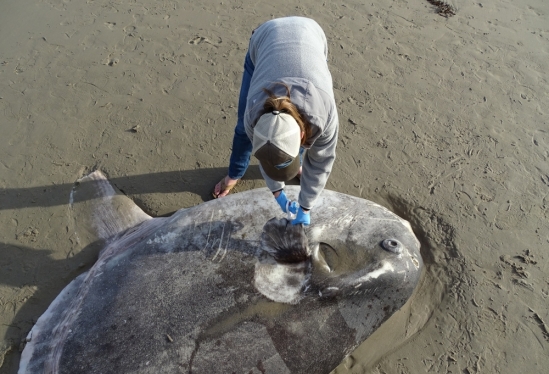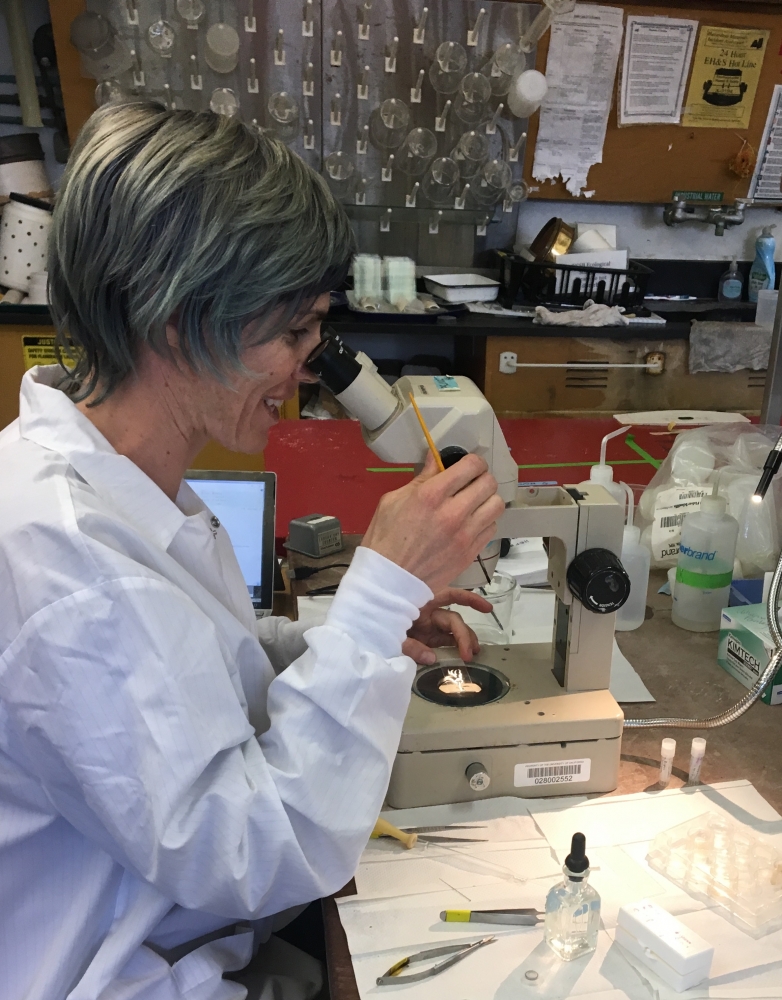
Out of the Deep Blue

Sometimes an opportunity shows up on your doorstep and you have to stop what you’re doing to take advantage of it. That’s what happened to the folks in Armand Kuris’ parasitology lab when a hoodwinker sunfish washed ashore near UC Santa Barbara February 19.
“We always interrupt whatever we’re doing when some adventure comes up,” said Kuris, a professor of zoology in the Department of Ecology, Evolution & Marine Biology.
Opportunities to study any sunfish are few and far between, he explained. Especially the elusive hoodwinker, which was first described in 2017. “It’s [for sure] the first time someone has looked at an identified hoodwinker sunfish,” he said, referring to the dissection.
In contrast to the hoodwinker, divers routinely encounter its equally large cousin, the ocean sunfish, in the Santa Barbara channel. But collecting a 10-foot, two-ton fish and transporting it all the way to the lab just for dissection is both unfeasible and wasteful, said Kuris. What’s more, sunfish live in open water and have no major fisheries to provide researchers with specimens.
“It’s a large creature in the open ocean and we don’t know very much about those things,” said Kuris. Scientists don’t have good estimates of how old the large ones are, much of what they eat or their place in ocean ecology. “One of the few things we do know is they’re heavily parasitized,” he said.
To wit, when Kuris and his team opened a small section of the fish’s intestines, a slew of tapeworms spilled onto the beach.
Kuris, a parasite ecologist, is sending samples to a variety of specialists who will help identify all the species living in the enormous fish. He also plans to get a better count on the numbers involved. But the work has already yielded insights even after just a few days.
“The parasites in the gut all came in as larvae from something the fish ate,” he explained. That helps to place the fish in the ocean’s food web.
Doctoral student Dana Morton examines tapeworms from the hoodwinker sunfish.
Photo Credit:
Dana Morton
Sunfish primarily eat jellyfish (or jellies), but as Kuris noted, most individual jellies don’t carry parasites. So finding tens of thousands of tapeworms in the fish’s intestines provides a lot of information. “It’s really saying that these things are consuming a lot of jellyfish, they’re living a very long time and they’re probably growing slowly,” he said. “And this information only comes from a glance at the tapeworms.”
He may also find larval parasites in the fish’s viscera, which may give some answers as to what, if anything, eats sunfish. “There is no other easy way to get this information,” he said.
Kuris and his colleagues at UC Santa Barbara pioneered this type of investigation when an outreach group found an oarfish off Catalina Island in 2013. Scientists know very little about this sea serpent-like fish, which spends most of its life in the inky depths some 600 to 3,300 feet below the surface.
The one thing scientists did know was that oarfish eat krill. Anytime scientists got one to dissect, its belly would be filled with krill shells. But Kuris’ team also found parasitic worms that live only in jellies. “So these things may also be eating a reasonable number of jellyfish,” he said. But since jellyfish don’t remain in the gut, researchers never knew they were part of the fish’s diet.
Studying the parasites also gave the team a glimpse into what animals might have a taste for oarfish. The fish had certain parasites that also show up in Mako sharks, and others that have been found inside birds and marine mammals. No bird is picking off 30-foot long fish, and there’s really only one mammal that could handle such a meal: the sperm whale. Suddenly, Kuris and his collaborators had insights on what eats oarfish, just by looking at what’s in its gut.
“We’re placing these large, mysterious animals in the marine food web,” he said.




